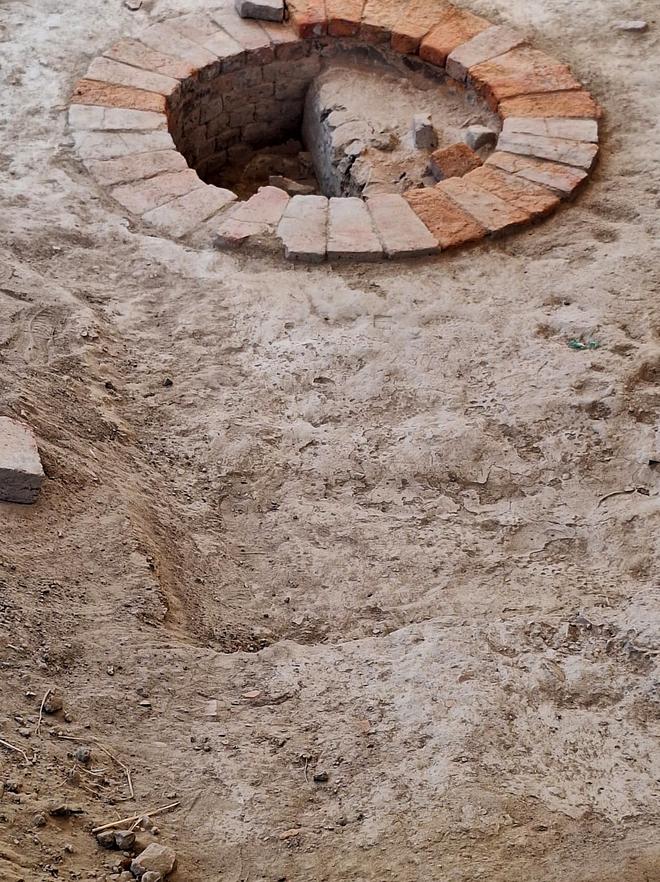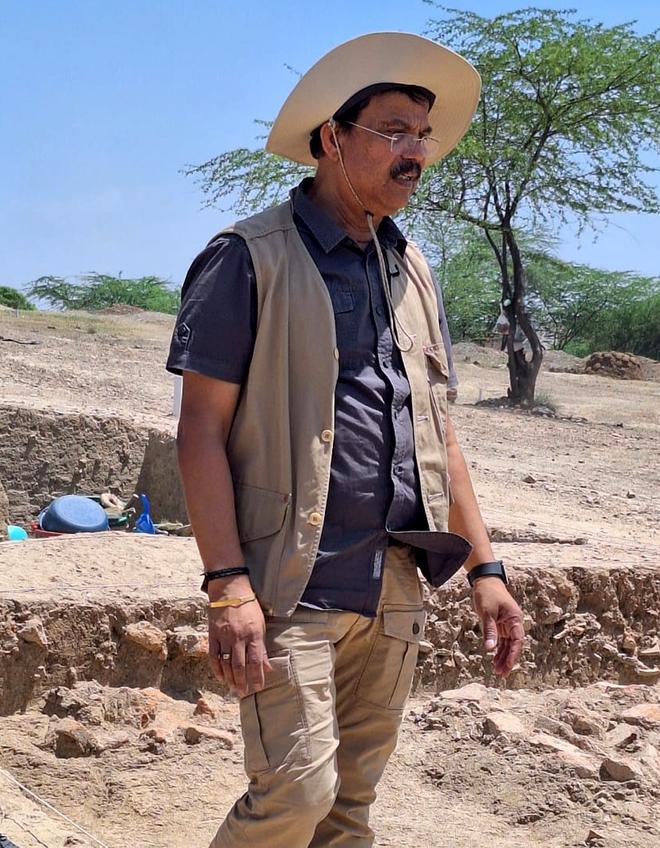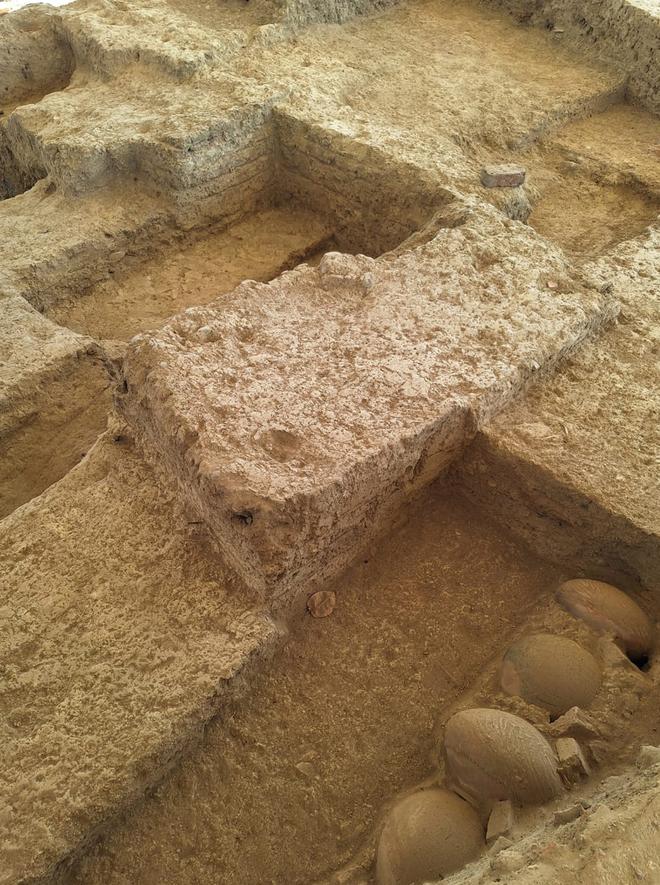Roughly 150 km from Delhi, the national capital, down the Delhi-Sirsa highway, a meandering road leads to the twin villages of Rakhi Shahpur and Rakhi Khas in Haryana’s Hissar district. The narrow, dusty road, typical of small-town India, belies the importance of the place to which it leads — the archaeological site of Rakhigarhi. A plaque here reads that it is the largest site of the Harappan culture. Ninety-nine years after it was discovered, the findings have raised questions about history and identity.
Mound 7 of the excavation site, that extends across 3.5 sq km or 350 hectares, has been identified as a burial plot from which 56 skeletons were recovered. Of these, a woman’s, roughly 4,600 years old, has created a buzz among those who work in history, anthropology, genomics, and linguistics. The DNA analysis of the skeleton says “the individual we sequenced fits as a mixture of people related to ancient Iranians (the largest component) and Southeast Asian hunter-gatherers”, as per Cell. It also says that there was no Steppe Pastoral gene (from people in Central Asia) in the Rakhigarhi woman.
The word Aryan has been interchangeably used for the Steppe Pastoralists (since we cannot say any time frame), though to avoid racial connotations many scholars now prefer to use the term Indo-Aryan for this group of people. This finding has fanned the debate on the so-called Aryan migration to India, part of the history books of many generations of Indians.
Quickly, the body that oversees educational aids, the National Council of Educational Research and Training (NCERT), sent out a document to incorporate the developments in the next academic year’s Class 12 History textbook Themes in India History Part - I under the chapter ‘Bricks, Beads and Bones - The Harappan Civilisation’. “The DNA of the Harappans has continued till today and a majority of the South Asian population appear to be their descendants. Due to trade and cultural contacts of the Harappans with distant regions, there is a mixture of genes in small quantities. The continuity without any break in genetic history as well as cultural history rules out large-scale immigration of the so-called Aryans,” the NCERT textbook aimed for 2024-25, has stated.

There is a difference of opinion among scientists, with one set associated with the project saying that the skeleton does indeed represent a “continuity in history”, meaning that the Harappan and Vedic cultures were both indigenous and not alien. Another set of historians says that the Harappan civilisation and those who wrote the Vedas were two different people.
ASI on ground
The findings were first published in two papers in 2019: one in the peer-reviewed journal Cell named ‘An Ancient Harappan Genome Lacks Ancestry from Steppe Pastoralists or Iranian Farmers’, co-authored by 28 scientists, and the other, ‘The Formation of Human Populations in South and Central Asia’ in Science, a 124-year-old publication.
Unlike most scientific discoveries restricted to a geeky bunch of professionals, these studies have generated an interest in the excavation work. The on-site team of the Archaeological Survey of India (ASI) that aims to protect, conserve, and discover the country’s tangible and intangible heritage, says after the study results were published, the number of lay people showing up to see the work they’re doing is now between 100 and 150 daily. The curious include students from schools and colleges from Delhi, Uttar Pradesh, and Rajasthan, and a number of foreign visitors.
At Rakhigarhi, the professorial Sanjay Manjul, chief archaeologist and head of the ASI team working on site, is excited. Unperturbed by Haryana’s dry afternoon heat, Manjul walks from mound to mound describing in detail what each one has thrown up so far. He talks about the mature urban planning, the clean structures of houses, and the organised drainage systems. He also points out cultural cues like fire altars and sacrificial pits and the presence of animal figurines: bulls, pigs, tigers. “Other antiquities include a variety of terracotta toys and jewellery, shell and stone ornaments, stone and copper tools and implements including chert blades, fluted cores, copper arrowheads, bone points, beads of semi-precious stones and other terracotta objects,” he says.

On-ground, the dig site is like something out of a movie. There are the dusty mounds, about 15 workers digging and a few ASI archaeologists supervising, with a camp site, where everyone, including Manjul, lives; there’s nothing else around. The people of Rakhigarhi are delighted that their town is important. Villagers show the way to the site with excitement. A former village sarpanch says he hopes that when the museum is complete, residents of his village will get employment.
Mound 1, which has been identified as a centre of industrial activity throughout the various phases of excavation here, includes evidence of a kiln for pottery production and tools for a lapidary industry for semi-precious stones. Remains of sun-dried unbaked bricks for homes and burnt-brick drains, along with a fire altar have also been found.
Mound 2 located in the south-west appears to have a 14-metre high citadel, a large podium, two sacrificial pit chambers, a granary, a market complex, house complexes, and two deep wells.
Way back in 1915, the Survey of India, ASI’s precursor, first documented a peculiar mound across the landscape of Rakhigarhi. The site was first added to archaeological data in 1968 and 1969, and has been subject to excavation by the ASI between 1997 and 2000, and by the Deccan College of Post Graduate Research Institute in collaboration with the State Archaeology Department of Haryana, between 2011 and 2016. The excavated material is with the Haryana State Archaeological Department, which the ASI says will soon be a part of a museum they’re building at the site.
According to Manjul, cultural continuity is established through all these excavations even if scientists set aside the DNA findings. “A whole lot of these remains can be correlated with Vedic culture, like the fire altars and sacrificial pits,” he says.
Some scientists say yes
Niraj Rai, scientist with the Birbal Sahni Institute of Palaeosciences, was one of the lead authors in the two genome projects. He says it is true that Harappan ancestry is present in most populations of India. But he also says that at present the local population of Rakhigarhi and most Indian populations have a significant part of the Steppe DNA in their genetic composition, sometimes up to 20%.
The summary of the Cell article, of which Rai is a lead author, says: “These individuals (the Harappans) had little, if any, Steppe pastoralist related ancestry, showing that it was not ubiquitous in north-west South Asia during the IVC (Indus Valley Civilization) as it is today.”
According to Rai, this is because some migration took place from the Steppe region after 1500 BCE and until about 500 BCE. These people intermingled with local populations. Both papers stated that Steppe Pastorals came to India between 2000 BCE to 1500 BCE.
He says the Rakhigarhi excavations show a “cultural continuity of over 5,000 years” though there was a genetic infusion after 1500 BCE. “Here we have very good evidence of the development of culture from 6000 BCE. This site is very important to understand the early development of Indian culture.”
This is an assessment archaeologists working on the excavation site agree with. Professor Vasant Shinde, former Vice Chancellor of Deccan College, University of Pune, who led some of the most important excavation work here, also agrees.

Shinde, who is also a co-author of the Cell study says, “There are genetic and archaeological indications that the Harappan and Vedic cultures are the same, though more research needs to be done. This (Harappa) has laid the base of Indian cultural civilisation. What we today follow is more or less a Harappan lifestyle. Many knowledge systems and traditions were introduced by the Harrapans and have continued for 5,000 years.”
Some scholars say no
The NCERT clarifies in the textbook that more research is required on the relationship between the Harappans and the Vedic people.
The crucial question now is: if Vedic and Harappan cultures are synonymous, how does that explain the development and use of Sanskrit, the language of the Rig Veda, considered the oldest book of Vedic literature and civilisation.There is no evidence of the language at the Rakhigarhi site.
Historian Romila Thapar, in a book co-authored by several others in 2019, Which of us are Aryans? says that “The standard chronology of what is called the Vedic period is taken to be from roughly 1500 to 500 BCE. This is the period of the composition of the first Veda, the Rig Veda, and then the later ones, the Samaveda, Yajurveda and finally the Atharvaveda.” She goes on to say, “The history of this period has become central to a political ideology that insists on the Aryan culture of the Vedas being the foundational culture of India, and of the Aryans therefore being entirely indigenous to the subcontinent and its earliest inhabitants. This is being projected as the popular explanation of how it all began, especially in northern India. However, it tends to be set aside by most historians.”
According to linguistics scholars, classical Sanskrit has emerged from the Indo-Aryan language ‘Rig Vedic Sanskrit’, in which the text is written. It has been believed until now that it was the Steppe migrants who brought in the Indo-Aryan languages, a sub-section of the Indo-Iranian branch of the Indo-European language family.
Though the paper in Cell says the natural path for the spread of the Indo-European languages (from which Sanskrit originates) was through Steppe Pastorals, he now contends that there was a need for research to re-look at the origin of Sanskrit and whether it could also have been indigenous to the Indian subcontinent.
Strongly rebutting this, linguist G.N. Devy says that accounts of evolution of languages are based on comparative and historical linguistics. They firmly indicate that Sanskrit, historically, has had no pre-Harappa existence in South Asia. He goes on to say that the claim that the DNA study of a Rakhigarhi skeleton disproves the previously established understanding of the language movement is “hasty, far-fetched, and agenda-driven rather than a dispassionate scientific analysis”.
The agenda he refers to is to prove the one-nation, one-origin theory. There have been many arguments since the publication of the two studies and subsequent interpretations in mass media.
In an interview to a coffee table book brought out by The Hindu in 2022, Tony Joseph, author of the book, Early Indians: The Story of Our Ancestors and Where We Came From, says, “…The disconnect between the Harappan Civilisation and the earliest Sanskrit text we have, the Rig Veda, is quite striking. The Harappan Civilisation was a leading urban civilisation having substantial trade contacts with other urban civilisations of its time…. The milieu of the Rig Veda is pastoral, with many of its verses focusing on how the Gods helped the Aryans in their battles with other pastoral tribes and in acquiring cattle wealth. The horse and the chariot are a dominant imagery in the Rig Veda. But the horse and the chariot are strikingly absent in the Harappan Civilisation — even as imagery on the thousands of seals it has left behind”.
As the debate remains open, some scholars feel both arguments could have been put to the students in the NCERT book, to show that history and science are not absolutes, but evolve with time, as further evidence comes to light.







